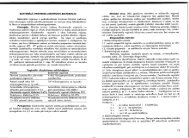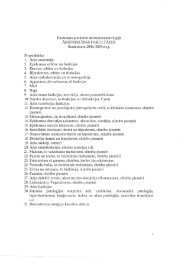PHYSICS
n - susliks.lv
n - susliks.lv
- No tags were found...
You also want an ePaper? Increase the reach of your titles
YUMPU automatically turns print PDFs into web optimized ePapers that Google loves.
Scala vestibuli (perilyumh)<br />
Bone<br />
Tectorial<br />
membrane<br />
200Hz<br />
300Hz 100Hz 50Hz<br />
fl~~;t,·, "!<br />
Scala media<br />
(endolymh)<br />
Tectorial<br />
membrane<br />
Basilar membrane<br />
Fig. 9.5. Schematic diagram of<br />
shearing force created between<br />
the hair cells and the tectorial<br />
membrane as a result of basilar<br />
membrane displacement<br />
20<br />
25<br />
30<br />
Fig. 9.6. Theory of von Bekesy:<br />
dependence of the position of<br />
maximum vibration amplitude<br />
on the sound frequency<br />
Scala tympany (perilyumh)<br />
Fig. 9.4. A cross section of the cochlea<br />
section of the cochlea. Essentially the organ contains two fluidfilled<br />
chambers divided by a membrane, called the basilar membrane.<br />
This membrane does not, however, completely separate<br />
the two chambers. A small opening, called the helicotrema, is present<br />
at the distal or innermost part of the system. The basilar<br />
membrane contains the neural detecting celfs, which are small<br />
hair-like cells which are triggered by shear effects occurring<br />
between the fluid and the membrane. Thus, any lateral or<br />
sideways motion of the membrane with respect to the fluid is<br />
detected. The oval window is forced to vibrate by the action of the<br />
ossicles which, in turn, causes an oscillating pressure in the<br />
upper chamber. This pressure can be equilibrated by the membrane<br />
bulging downward. The bulging process produces the shearing<br />
effects which can be detected by the hairs which are located<br />
between the tectorial and basilar membranes (fig. 9.5). The nervous<br />
system then transmits the signal to the brain. According to<br />
von Bekesy's theory, different frequencies will cause a maximum<br />
vibration amplitude at different points along membrane (fig. 9.6).<br />
Birds. Hearing is particularly important when the birds rest or<br />
perch. It also facilitates communication over long distances in<br />
vegetative or arboreal environments where vision may be partially<br />
or completely occluded. Birds (like mammals) have an external<br />
ear and an ear canal which leads to a recessed ear drum. In many<br />
76<br />
birds, the outer opening of the ear canal is surrounded by specialized<br />
feathers in the form of a funnel which act as an efficient<br />
sound collector. The facial ruff of certain owls is shaped either<br />
like a single parabola or as two parabolas side by side, separated<br />
by the beak at the midline. Such a design increases the animal's<br />
acoustic sensitivity. Peak sensitivity for birds occurs at 2 kHz. One<br />
of the most interesting characteristics of a birds' auditory system is<br />
the ability to resolve the small differences that exist in the<br />
frequency of most sounds, called frequency modulation. Birds are<br />
able to detect a frequency change of only 10 - 15 Hz. These slow<br />
or rapid changes in acoustic frequency enable a bird to recognize a<br />
member of its own species. In birds, the ability to determine the<br />
exact location of a sound source depends on a variety of factors.<br />
The barn owl, for instance, is capable of orienting to a sound<br />
source in space with an error of less than 2 degrees.<br />
Fish have a labyrinth, or inner ear which extends their hearing<br />
to higher frequencies. Sound waves travel to chambers where<br />
small granules called otholits are located. These granules stimulate<br />
sensory hair cells and trigger action potentials in the neurons of<br />
the auditory nerve.<br />
The gas bladders of some fish also provide an area of variable<br />
density. Vibrations pass through the gas bladder and travel<br />
through a pathway of small bones called Weber ossicles. These<br />
serve to connect the gas bladder directly with the inner ear<br />
of the fish.<br />
77






